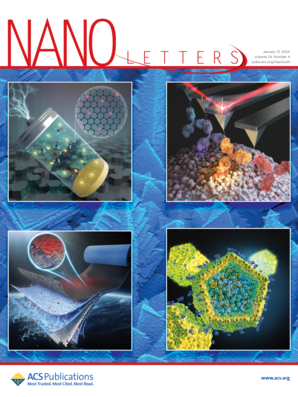Gradient Structured Separator Enables Stable Aqueous Zinc Metal Batteries
IF 9.6
1区 材料科学
Q1 CHEMISTRY, MULTIDISCIPLINARY
引用次数: 0
Abstract
Developing a functional separator is an important strategy to improve the electrochemical performance of the Zn anode by suppressing the Zn dendrite growth and parasitic side reactions, thus advancing the aqueous zinc-ion batteries. Herein, we experimentally realize functional separator with gradient-structure based on CeF3 nanoparticles functionalized glass fibers. The experimental and theoretical results confirmed that the functional separator can tailor the Zn2+ flux and restrain SO42– transport, promoting dense Zn deposition. The strong interaction between CeF3 nanoparticles and H2O separates Zn2+ and H2O at the electrolyte/Zn anode interface, suppressing side reactions. Consequently, the Zn||Zn with this separator achieves excellent cycling stability of 2500 h at 1 mA cm–2 and 1 mAh cm–2 and 1000 h at 5 mA cm–2 and 5 mAh cm–2. This design of a functionalized separator provides a distinctive solution for the development of aqueous zinc-ion batteries.

梯度结构分离器使水锌金属电池稳定
开发功能分离器是通过抑制锌枝晶生长和寄生副反应来提高锌阳极电化学性能的重要策略,从而推动了水性锌离子电池的发展。在此,我们实验实现了基于CeF3纳米颗粒功能化玻璃纤维的梯度结构功能分离器。实验和理论结果均证实,该功能分离器可调节Zn2+通量,抑制SO42 -输运,促进致密Zn沉积。CeF3纳米颗粒与H2O之间的强相互作用使电解质/Zn阳极界面上的Zn2+和H2O分离,抑制了副反应。因此,使用该分离器的Zn||Zn在1 mA cm-2和1 mAh cm-2下可达到2500小时的优异循环稳定性,在5 mA cm-2和5 mAh cm-2下可达到1000小时。这种功能化分离器的设计为水性锌离子电池的发展提供了一种独特的解决方案。
本文章由计算机程序翻译,如有差异,请以英文原文为准。
求助全文
约1分钟内获得全文
求助全文
来源期刊

Nano Letters
工程技术-材料科学:综合
CiteScore
16.80
自引率
2.80%
发文量
1182
审稿时长
1.4 months
期刊介绍:
Nano Letters serves as a dynamic platform for promptly disseminating original results in fundamental, applied, and emerging research across all facets of nanoscience and nanotechnology. A pivotal criterion for inclusion within Nano Letters is the convergence of at least two different areas or disciplines, ensuring a rich interdisciplinary scope. The journal is dedicated to fostering exploration in diverse areas, including:
- Experimental and theoretical findings on physical, chemical, and biological phenomena at the nanoscale
- Synthesis, characterization, and processing of organic, inorganic, polymer, and hybrid nanomaterials through physical, chemical, and biological methodologies
- Modeling and simulation of synthetic, assembly, and interaction processes
- Realization of integrated nanostructures and nano-engineered devices exhibiting advanced performance
- Applications of nanoscale materials in living and environmental systems
Nano Letters is committed to advancing and showcasing groundbreaking research that intersects various domains, fostering innovation and collaboration in the ever-evolving field of nanoscience and nanotechnology.
 求助内容:
求助内容: 应助结果提醒方式:
应助结果提醒方式:


